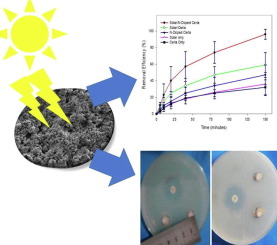Chemical Engineering Journal ( IF 15.1 ) Pub Date : 2020-03-26 , DOI: 10.1016/j.cej.2020.124869 Jibran Iqbal , Noor S. Shah , Murtaza Sayed , Javed Ali Khan , Nawshad Muhammad , Zia Ul Haq Khan , Saif-ur-Rehman , Muhammad Naseem , Fares M. Howari , Yousef Nazzal , Nabeel Khan Niazi , Aseel Hussein , Kyriaki Polychronopoulou

|
In this study, highly crystalline, mesoporous, small sized, stable, and efficient nitrogen-doped (N-doped) Ceria nanoparticles were synthesized using deep eutectic solvent (DES) and used for the photocatalytic degradation of sulfamethaxazole (SMX), a widely used human medication and emerging water contaminant. The N-doped Ceria resulted in 96% removal of SMX versus 59% by Ceria under solar irradiation at 150 min time using [SMX]0 = 10 mg/L and [Ceria]0 = [N-doped Ceria]0 = 0.5 g/L. The solar irradiation of the photocatalysts produced ●OH which was proved with electron spin resonance (ESR) spectroscopy and radical scavenger studies and the resulting ●OH caused the degradation of SMX. The ●OH showed high second-order rate constant with SMX, e.g., 4.9 × 109 M−1 s−1. The photocatalytic degradation of SMX was influenced by pH, concentrations of SMX and photocatalysts, inorganic anions, and natural organic matter. The kinetics of the photocatalytic degradation of SMX was found to be pseudo-first-order. The SMX degradation resulted into several products which were identified by UPLC-MS/MS and the resulting products were used to establish degradation pathways of SMX. The synthesized Ceria and N-doped Ceria also showed good antimicrobial activities towards Staphylococcus aureus and Escherichia coli. The treatment of SMX showed high reusability of N-doped Ceria, low leaching of cerium ions into reaction solution, and high decline in toxicity of SMX which suggests high potential of the synthesized nanoparticles towards SMX degradation.
中文翻译:

深度共晶溶剂中氮掺杂二氧化铈纳米粒子的合成,用于在太阳辐射下降解磺胺甲恶唑和其他抗菌活性
在这项研究中,使用深共晶溶剂(DES)合成了高度结晶,中孔,小尺寸,稳定且有效的氮掺杂(N掺杂)二氧化铈纳米颗粒,并将其用于广泛使用的磺胺甲恶唑(SMX)的光催化降解。人类药物和新兴的水污染物。在150分钟的太阳辐射下,使用[SMX] 0 = 10 mg / L和[Ceria] 0 = [N掺杂Ceria] 0 = 0.5 g ,N掺杂的Ceria导致SMX去除96%,而Ceria去除59%。/升 光催化剂的太阳辐射产生● OH,将其用电子自旋共振(ESR)光谱学和自由基清除剂的研究,将所得证明● OH引起SMX的降解。该●OH在SMX中显示出较高的二阶速率常数,例如4.9×10 9 M -1 s -1。SMX的光催化降解受到pH值,SMX和光催化剂的浓度,无机阴离子和天然有机物的影响。发现SMX的光催化降解动力学是伪一级。SMX降解产生了几种产品,通过UPLC-MS / MS鉴定了这些产物,并将所得产物用于建立SMX的降解途径。合成的二氧化铈和氮掺杂的二氧化铈对金黄色葡萄球菌和大肠杆菌也显示出良好的抗菌活性。。SMX的处理显示出高掺杂的N掺杂二氧化铈,铈离子浸入反应溶液中的可能性低以及SMX毒性的大幅下降,这表明合成的纳米粒子具有SMX降解的高潜力。



























 京公网安备 11010802027423号
京公网安备 11010802027423号